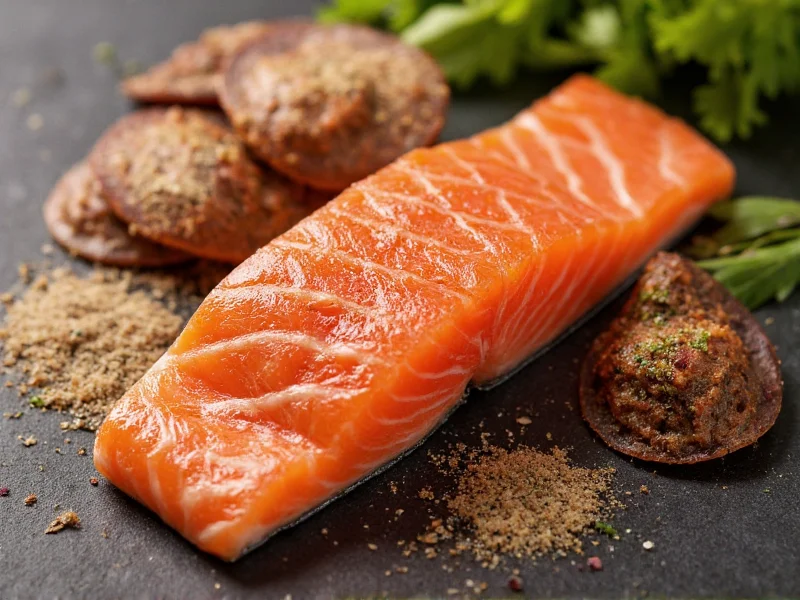Seasoning salmon properly transforms this delicate fish from ordinary to extraordinary. Unlike stronger meats, salmon requires a thoughtful approach to seasoning that complements rather than competes with its rich, buttery flavor. The right blend not only enhances taste but also creates a beautiful crust during cooking while keeping the interior moist and flaky.
Why Proper Salmon Seasoning Matters
Salmon's unique fat content and delicate texture demand specific seasoning considerations. Overpowering spices can mask its natural flavor, while insufficient seasoning leaves it tasting bland. The ideal salmon seasoning achieves three critical goals: enhancing natural flavors, creating textural contrast through proper browning, and balancing the fish's inherent richness with complementary notes.
Key Components of Effective Salmon Seasoning
Understanding these fundamental elements helps you create versatile seasoning blends for any cooking method or dietary preference:
Salt: The Essential Foundation
Kosher salt remains the professional choice for salmon seasoning due to its clean flavor and easy measurement. Use 1 teaspoon per pound of salmon, applied 15-20 minutes before cooking to allow proper penetration. For those monitoring sodium intake, reduce to ¾ teaspoon and compensate with additional acid components.
Acid Components: Brightness Without Overpowering
Lemon zest provides concentrated citrus flavor without the moisture of juice that can prevent proper searing. One teaspoon of finely grated zest per pound delivers brightness that cuts through salmon's richness. Alternatives include lime zest for Mexican-inspired dishes or orange zest for Asian preparations.
Aromatic Herbs: Flavor Without Heat
Fresh dill remains the classic pairing for salmon, but other herbs work beautifully depending on your preparation method. For baked salmon, try these herb combinations:
| Cooking Method | Recommended Herbs | Quantity per Pound |
|---|---|---|
| Baking | Dill, tarragon, chives | 1 tbsp fresh or 1 tsp dried |
| Grilling | Rosemary, thyme, oregano | 2 tsp fresh or ½ tsp dried |
| Pan-searing | Dill, parsley, chives | 1½ tbsp fresh |
| Smoking | Thyme, sage, marjoram | 1 tsp dried |
Five Proven Salmon Seasoning Blends
1. Classic Lemon-Dill Blend (Best for Baked Salmon)
This versatile blend works perfectly for oven-baked salmon fillets. Combine:
- 1 tsp kosher salt
- ½ tsp black pepper
- ½ tsp garlic powder
- 1 tsp lemon zest
- 1 tbsp fresh dill, finely chopped
- 1 tsp olive oil (helps seasoning adhere)
Apply evenly to salmon 20 minutes before baking at 400°F for 12-15 minutes.
2. Mediterranean Herb Blend
Ideal for grilled salmon with vegetables. Mix:
- 1 tsp sea salt
- ½ tsp black pepper
- 1 tsp dried oregano
- ½ tsp dried thyme
- 1 tsp lemon zest
- 1 clove garlic, minced
Massage into salmon and let rest 15 minutes before grilling over medium heat.
3. Smoky Paprika Blend (Best Salmon Seasoning for Grilling)
Creates a beautiful crust on grilled salmon:
- 1 tsp kosher salt
- ½ tsp black pepper
- 1 tsp smoked paprika
- ½ tsp garlic powder
- ½ tsp onion powder
- 1 tsp fresh lemon juice
Apply just before grilling to prevent burning of the paprika.
Timing and Application Techniques
When seasoning salmon, timing affects both flavor and texture. For best results:
- Apply salt-based seasonings 15-20 minutes before cooking to allow penetration
- Delicate fresh herbs should be applied just before cooking
- For skin-on salmon, season both sides but focus on the flesh side
- Use your fingers to gently press seasoning into the surface
- For thicker cuts, increase seasoning by 25%
Common Seasoning Mistakes to Avoid
Even experienced cooks make these salmon seasoning errors:
- Over-seasoning with strong spices: Avoid cayenne, curry powder, or chili flakes in large quantities
- Seasoning too early: Acidic components applied more than 30 minutes before cooking can start to "cook" the fish
- Ignoring moisture content: Pat salmon dry before seasoning for better adhesion
- Using table salt instead of kosher: Table salt is denser and can lead to oversalting
- Seasoning only the top: Flavor should penetrate from all sides
Storage Tips for Homemade Seasoning Blends
Create larger batches of dry seasoning blends for convenience. Store in airtight containers:
- Dry blends last 3-4 months in a cool, dark place
- Add fresh herbs only when ready to use
- Label containers with date and intended use
- For best flavor, replace dried herbs every 6 months
Adapting Seasoning for Dietary Needs
Modify your salmon seasoning for specific dietary requirements:
- Low-sodium: Reduce salt to ¾ tsp and increase lemon zest to 1½ tsp
- Keto-friendly: All standard seasoning blends are naturally keto-compliant
- Gluten-free: Ensure all spice components are certified gluten-free
- Allium-free: Replace garlic powder with fennel seed (crushed)











 浙公网安备
33010002000092号
浙公网安备
33010002000092号 浙B2-20120091-4
浙B2-20120091-4